

Don’t Scan So Close To Me: Scanning Sting’s Musical Brain – Neuroscience News. Summary: New imaging technology allowed researchers to map how Sting’s brain organizes music.
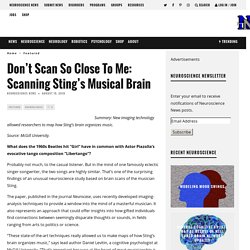
Source: McGill University. Training of Thought: Critical Thinking for Writing. On the Origin of Truly Innovative Ideas. Last week, I wrote about increasing innovation in your company.

This week, in Part 2, we'll talk about how to create the right environment and incentives for innovation to flourish. Don't Overthink It, Less Is More When It Comes to Creativity. Most of us have experienced writer’s block at some point, sitting down to write, paint or compose only to find we can’t get the creative juices flowing.
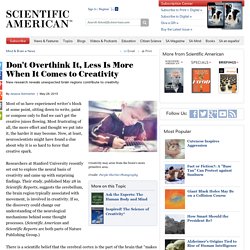
Most frustrating of all, the more effort and thought we put into it, the harder it may become. Now, at least, neuroscientists might have found a clue about why it is so hard to force that creative spark. Researchers at Stanford University recently set out to explore the neural basis of creativity and came up with surprising findings. Their study, published May 28 in Scientific Reports, suggests the cerebellum, the brain region typically associated with movement, is involved in creativity. Shimpei Takahashi: Play this game to come up with original ideas. The Science of Stress, Orgasm and Creativity: How the Brain and the Vagina Conspire in Consciousness. Legendary Psychoanalyst Adam Phillips on Why the Capacity for Boredom Is Essential for a Full Life.
By Maria Popova “Boredom … protects the individual, makes tolerable for him the impossible experience of waiting for something without knowing what it could be.”

When was the last time you were bored — truly bored — and didn’t instantly spring to fill your psychic emptiness by checking Facebook or Twitter or Instagram? How Mind-Wandering and “Positive Constructive Daydreaming” Enhance Creativity and Improve Our Social Skills. By Maria Popova The science of why fantasy and imaginative escapism are essential elements of a satisfying mental life.
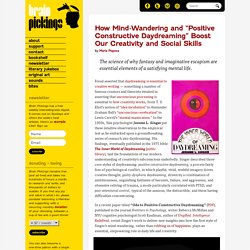
The Science of How Music Enchants the Brain, Animated. Theconversation. Think of your favourite piece of music.

Do you get shivers when the music swells or the chorus kicks in? Or are the opening few bars enough to make you feel tingly? Despite having no obvious survival value, listening to music can be a highly rewarding activity. Why we love repetition in music – Elizabeth Hellmuth Margulis. What is music?

How Music Affects and Benefits Your Brain. Charles Limb: Your brain on improv. The Science of Breaking Out of Your Comfort Zone (and Why You Should) The spark of epiphanies: Q&A with John Kounios. Cognitive neuroscientist John Kounios was curious: what happens in the brain when someone has a great idea?
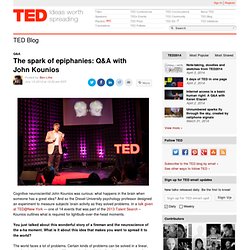
And so the Drexel University psychology professor designed an experiment to measure subjects’ brain activity as they solved problems. In a talk given at TED@New York — one of 14 events that was part of the 2013 Talent Search – Kounios outlines what is required for lightbulb-over-the-head moments. You just talked about this wonderful story of a fireman and the neuroscience of the a-ha moment. What is it about this idea that makes you want to spread it to the world? Goethe on the Psychology of Color and Emotion. Color is an essential part of how we experience the world, both biologically and culturally.
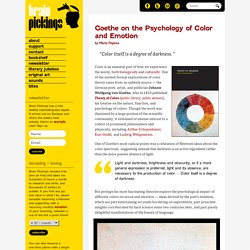
One of the earliest formal explorations of color theory came from an unlikely source — the German poet, artist, and politician Johann Wolfgang von Goethe, who in 1810 published Theory of Colors (public library; public domain), his treatise on the nature, function, and psychology of colors. Milton Glaser on Art, Technology, and the Secret of Life. By Maria Popova “You learn more and more that everything exists at once with its opposite, so the contradictions of life are never-ending and somehow the mediation between these opposites is the game of life.” Few things today are truly iconic, but the I♥NY logo is among them. Patricia Leavy, PhD. I am a sociologist by training.

I come from academic world, reading scholarly articles on topics of social import, but they’re almost always boring, dry and quickly forgotten. Yet I can’t count how many times I’ve gone to a movie, a theater production or read a novel and been jarred into seeing something differently, learned something new, felt deep emotions and retained the insights gained. I know from both my research and casual conversations with people in daily life that my experiences are echoed by many. The arts can tap into issues that are otherwise out of reach and reach people in meaningful ways. Artists 'have structurally different brains'
17 April 2014Last updated at 05:35 ET By Melissa Hogenboom Science reporter, BBC Radio Science Brain scans revealed artists have more grey matter in parts of their brains Artists have structurally different brains compared with non-artists, a study has found. Participants' brain scans revealed that artists had increased neural matter in areas relating to fine motor movements and visual imagery. The research, published in NeuroImage, suggests that an artist's talent could be innate. But training and environmental upbringing also play crucial roles in their ability, the authors report. 40/40 Vision Lecture: Neurology and the Passion for Art. Beautiful Minds, Scientific American Blog Network.